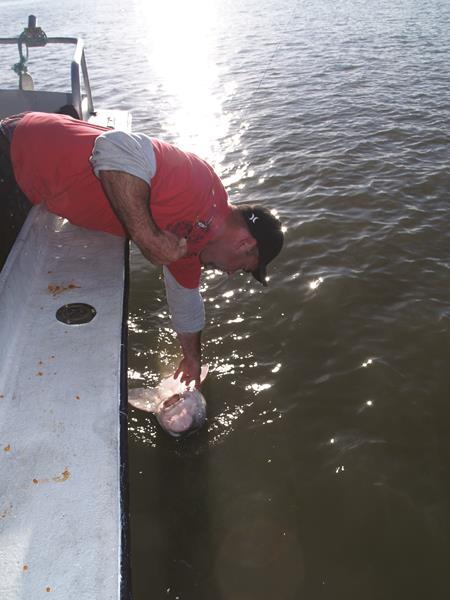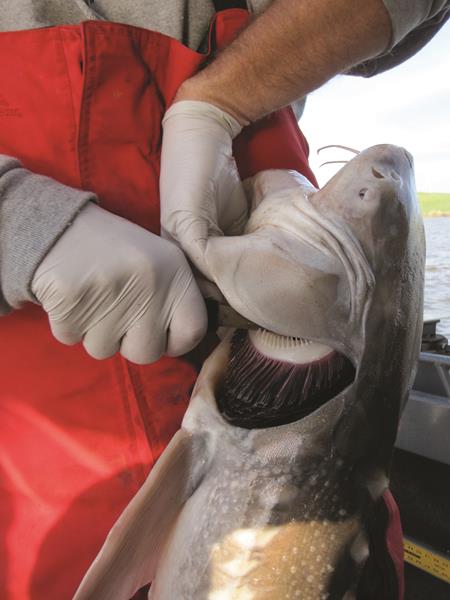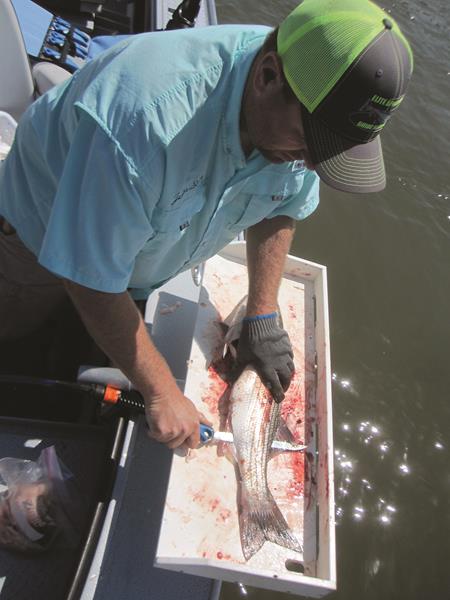When you catch a striper or sturgeon a fundamental question pops up. Will you keep the fish for the table or will you release it? Since both species of fish are subject to size limits, this decision will be made for you at times.
As of this writing, stripers must be at least 18 inches in length to be kept, while sturgeon must fall between 40 and 60 inches, measured to the fork of the tail.
Releasing sturgeon is a piece of cake. They are extremely hardy fish that very seldom swallow the bait. This being the case, to release a sturgeon all you need to do is pop out the hook with your pliers, hold the fish beside the boat, revive it and let it go.

Releasing stripers can be dicey, since they often swallow the bait and are hooked in the throat or deeper. For bass that are hooked deep, the simplest and safest method is to cut the leader as close to the hook as possible and release the fish with the hook still imbedded. Over time the striper’s body will either eject or dissolve the hook.
At this point, let’s take a moment to consider the size of the fish you keep. When it comes to sturgeon, size isn’t important, beyond making sure the fish falls within the legal slot.
Stripers are a different story. Large stripers, say fish over 15 pounds, while still decent to eat aren’t nearly as good as smaller fish. For this reason, I release almost all the bass I catch that are over 15 pounds.
The meat of small stripers, in the 18 to 22 inch range tastes great, but there isn’t a whole lot of meat on these bass. As a result, I also release most of the small keepers that I catch. I prefer to keep stripers that are in the 6 to 10 pound range. Fish of this sized provide a lot of mild tasting, top quality meat.
All in all, releasing stripers and sturgeon unharmed is a pretty simple proposition. Cleaning the stripers and sturgeon that you choose to bring home for eating is a fairly simple process as well.
The road to quality fish actually begins out on the water, with bleeding the fish. By bleeding the stripers and sturgeon you keep, you’ll insure that no blood settles into the meat, which makes for dark colored, strong-tasting fillets. To bleed stripers and sturgeon, simply cut the fish’s gills using either a knife or scissors.
Okay, so you’ve kept a couple stripers or a sturgeon for eating, you’ve bled them and you are now back on land. It’s time to clean your catch. Stripers are the easiest to clean, so let’s start with them.
Most folks like to fillet stripers. For filleting you’ll need a large keenly honed filleted knife and a fairly large flat surface to work on. With the striper laying on its side grasp the fish by its head using one hand.
Using the other hand position the knife blade under the pectoral fin and make a slice downward at a steep angler toward the head across the fish’s body, until the blade comes up against the striper’s spine. At that point turn the blade and begin cutting toward the tail, keeping the blade gliding right along the spine.
When you get down to the tail, leave the fillet attached. Next pick up the fillet, turn it over and lay it out with the meat side up. Holding down firmly on the striper’s body with one hand, ease the knife into the fillet near the tail at a flat angle until the blade is right up against the skin. Using a back and forth slicing action while keeping the blade almost flat, work your way down the length of the fillet until the meat is completely detached from the skin. Next flip the bass over and repeat the process.
The first couple bass you fillet will be an adventure, but after that you’ll develop a feel for filleting and you’ll be able to fillet a bass in two or three minutes.
Once the fillets are detached from the bass there is still one more step to complete before you are done. You’ll notice a red strip of meat lying right along the middle of the fillet.
The red meat has a strong fishy flavor, so you’ll want to remove it. This is easily done by making a V cut along the edges of the red meat so the red meat can be lifted out in one long strip.

Sturgeon are a lot tougher to clean than stripers and there are a number of different methods that can be used. I still employ a method that was taught to me by Barry Canevaro years ago that is quick and simple.
Begin by laying the sturgeon on the cutting board with its belly down. Using a sharp knife, make a shallow cut under the diamond shaped projections and fins along the back of the fish. If you do this properly all the diamonds and fins should come off in one long strip. Next do the same thing on either side if the fish to remove the diamonds that line its flanks.
With all the bony projects removed, it’s time to get down to the business of filleting. With the fish resting upright with its belly against the cutting board begin by making two cuts, one on either side of the fish, behind the pectoral fins to the depth of the spine.
Next make a cut down the length of the sturgeon’s back working from the head toward the tail over the area where the spine should be located. Before you get very deep, you’ll encounter cartilage, working carefully maneuver the knife along the edge of the cartilage and continued working down the fish’s body.

As you work you’ll note that a thick fillet of meat with the skin attached will fold down along the length of the sturgeon body. Eventually the thickness of the meat with decrease and as you get down toward the sturgeons stomach the knife will come up against skin. At that point cut through the skin.
You will end up with a long thick fillet with skin on one side that has been completely removed from the sturgeon’s body. After repeating this process on the other side of the fish it’s time to remove the skin from your fillets.
This is done in the same way you’d separate the meat from the skin on a striper, except you are working with a much larger piece of meat. I like to begin by poking a hole through the fillet at the narrow end. I place the index finger of my left hand through the whole.
Next, with the knife in my right hand, I make my flat cut through the meat down to the skin and work the knife down the length of the fillet until the meat has been completely detached from the skin. Finally remove any red meat from the fillets, rinse them off, cut the fillets into meal size pieces and Mr. Sturgeon is ready for the freezer.
